
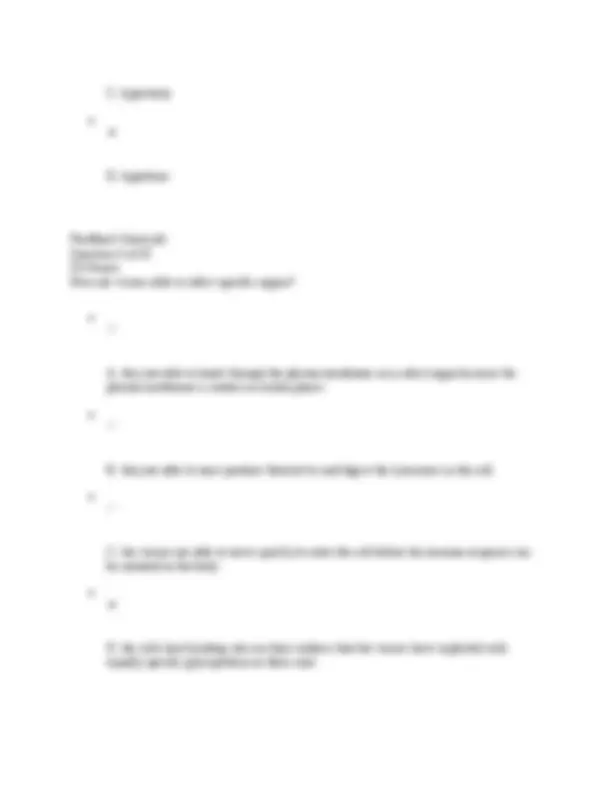


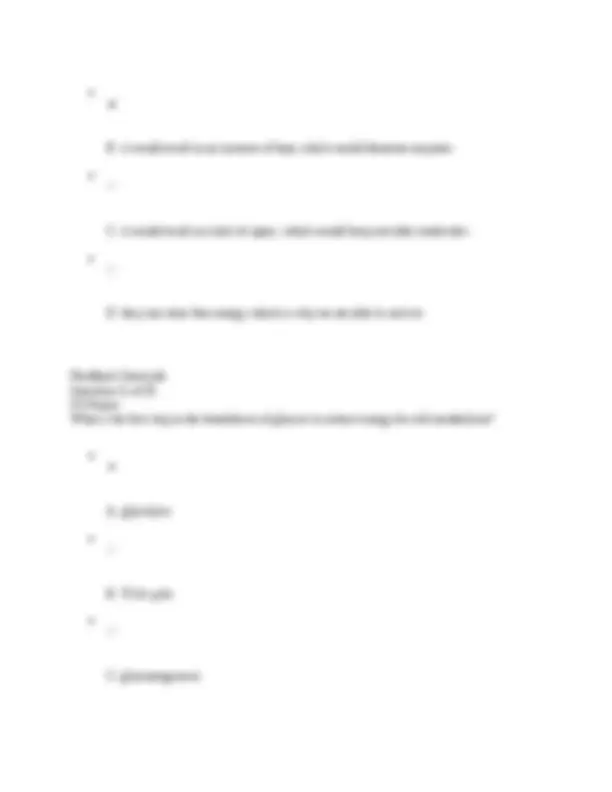

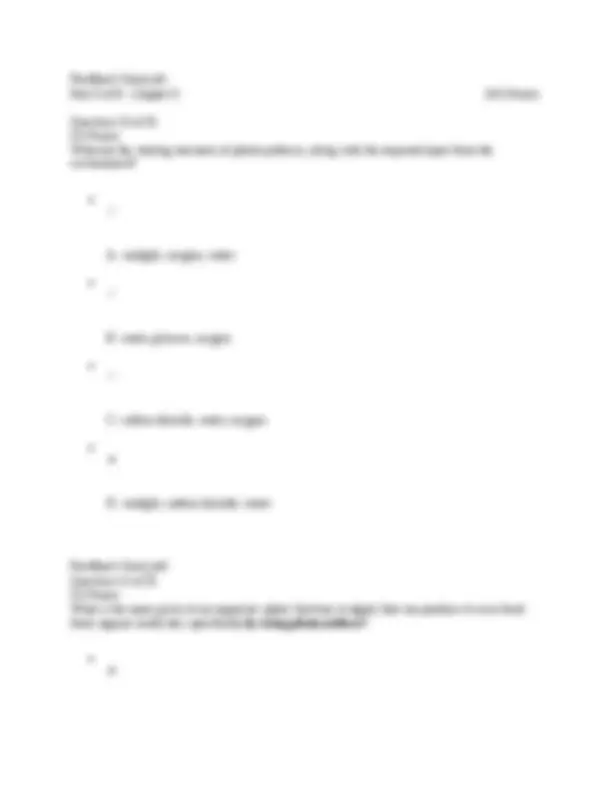


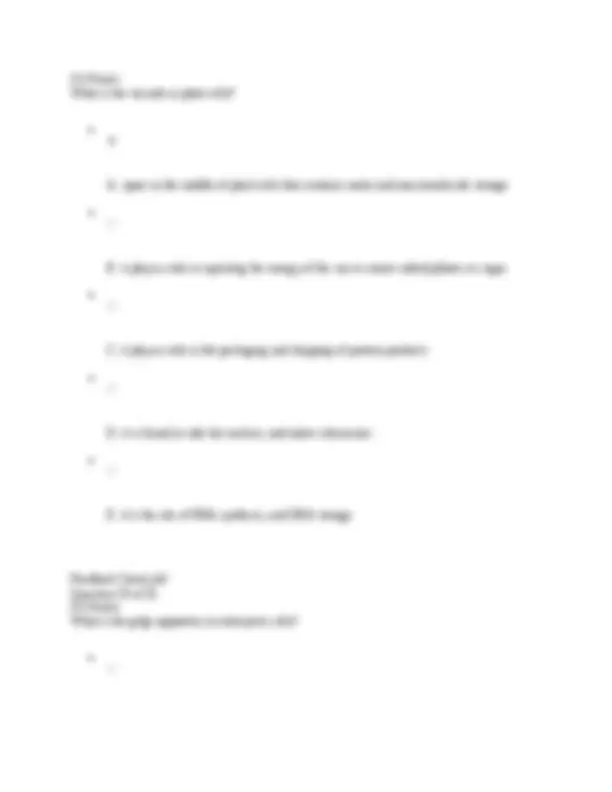





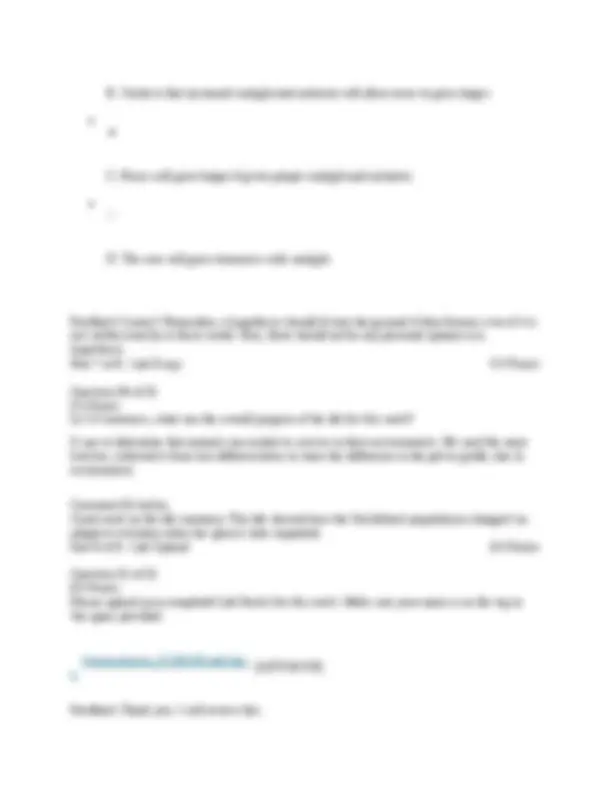



Study with the several resources on Docsity

Earn points by helping other students or get them with a premium plan


Prepare for your exams
Study with the several resources on Docsity

Earn points to download
Earn points by helping other students or get them with a premium plan
Community
Ask the community for help and clear up your study doubts
Discover the best universities in your country according to Docsity users
Free resources
Download our free guides on studying techniques, anxiety management strategies, and thesis advice from Docsity tutors
Rubisco is involved in photosynthesis, and helps to speed up the reaction from carbon dioxide to water. What is the generic term for rubisco
Typology: Exams
1 / 24

This page cannot be seen from the preview
Don't miss anything!

















Quiz 3 Part 1 of 8 - Chapter 3 18.0 Points Question 1 of 31 3.0 Points In an electron microscope, what type of cells are used? A. dead, processed cells B. live and fresh cells C. live, processed cells D. dead, but fresh cells Feedback:The processing and prep for electron microscopy kills the cells, and it is usually done in a vacuum. Review microscopy in Chapter 3. Question 2 of 31 3.0 Points Which is typically the most prominent organelle in a eukaryotic cell?
A. lysosome B. peroxisome C. nucleus D. mitochondria Feedback:Great job. Question 3 of 31 3.0 Points If a solution outside of a cell has a lower concentration of solutes inside of a cell, it is referred to as what? A. facilitated B. isotonic
Feedback:Great job. Question 5 of 31 3.0 Points Which structure carries out oxidation reactions that break down fatty acids and amino acids? A. ribosomes B. mitochondria C. peroxisomes D. chloroplasts Feedback:Great job. Question 6 of 31 3.0 Points Which is the only substance involved in osmosis? A. alcohol
B. water C. sugar D. salt Feedback:Great job. Part 2 of 8 - Chapter 4 18.0 Points Question 7 of 31 3.0 Points What does the first law of thermodynamics state? A. There is and always will be the exact same amount of energy in the universe. B. As temperature approaches absolute zero, the entropy approaches a constant minimum.
3.0 Points Rubisco is involved in photosynthesis, and helps to speed up the reaction from carbon dioxide to water. What is the generic term for rubisco? A. endergonic B. enzyme C. exergonic D. substrate Feedback:Certain proteins help to lower the activation energy of chemical reactions inside of a cell. Review energy and metabolism in Chapter 4. Question 10 of 31 3.0 Points Why can’t cells store extra free energy? A. it would result in a lowering of heat, which would freeze the cells
B. it would result in an increase of heat, which would denature enzymes C. it would result in a lack of space, which would keep out other molecules D. they can store free energy, which is why we are able to survive Feedback:Great job. Question 11 of 31 3.0 Points What is the first step in the breakdown of glucose to extract energy for cell metabolism? A. glycolysis B. TCA cycle C. gluconeogenesis
Feedback:Great job. Part 3 of 8 - Chapter 5 18.0 Points Question 13 of 31 3.0 Points What are the starting reactants of photosynthesis, along with the required input from the environment? A. sunlight, oxygen, water B. water, glucose, oxygen C. carbon dioxide, water, oxygen D. sunlight, carbon dioxide, water Feedback:Great job! Question 14 of 31 3.0 Points What is the name given to an organism (plant, bacteria or algae) that can produce its own food from organic molecules specifically by using photosynthesis?
photoautotroph B. heterotroph C. autotroph D. chemoautotroph Feedback:Great job! Question 15 of 31 3.0 Points If we think of the electromagnetic spectrum, which type of wavelength has the most energy? A. short, stretched waves
D. the loss of sugar Feedback:Great job! Question 17 of 31 3.0 Points During the light-dependent reactions of photosynthesis, what are the two energy-carrier molecules that absorb the energy from sunlight? A. ATP and water B. ADP and NADPH C. ATP and NADPH D. ADP and ATP E. NADPH and water
Feedback:Great work! Question 18 of 31 3.0 Points What are the two main byproducts of photosynthesis? A. Oxygen and Water B. Carbon Dioxide and Water C. Glucose and Oxygen D. Carbon Dioxide and Oxygen E. Glucose and Carbon Dioxide Feedback:Photosynthesis is one of the most important reactions in nature. Knowing the reactants and byproducts is important. Review the overall equation for photosynthesis in Chapter 5 for more information. Part 4 of 8 - Lecture ELF 9.0 Points Question 19 of 31
A. it plays a role in capturing the energy of the sun to create carbohydrates or sugar B. space in the middle of plant cells that contains water and macromolecule storage C. it plays a role in the packaging and shipping of protein products D. it is found in side the nucleus, and makes ribosomes E. it is the site of RNA synthesis, and DNA storage Feedback:Great job! Question 21 of 31 3.0 Points What is the result of mitosis? A. Two cells become four identical cells
B. Two cells become four non-identical cells C. One cell becomes two identical cells D. One cell becomes two non-identical cells Feedback:Great job! Part 5 of 8 - Lab Material 15.0 Points Question 22 of 31 3.0 Points In which lake were there more stickleback with pelvic spines? A. Vixen Lake B. Rabbit Foot Lake C. Coyote Lake
Feedback:Great. Question 24 of 31 3.0 Points The pelvic spines in the stickleback are modified what? A. legs B. gills C. limbs D. fins Feedback:Review Lab 3: Stickleback Evolution, Part 1 Question 25 of 31 3.0 Points The loss of stickleback pelvic spines is similar to the loss of which body parts in some other four-legged vertebrates? A. hind limbs
B. divergent thumbs C. gills D. fins Feedback:Great. Question 26 of 31 3.0 Points What type of stain did we use for the fish? A. Toluidine Blue B. Alizarin Red C. Reticulin Stain